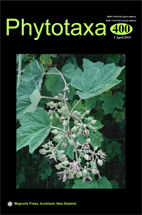Abstract
Rubus huagaoxiensis and R. lingtianus, two new species of Rosaceae from Sichuan, Southwest China, are described and illustrated. Rubus huagaoxiensis is morphologically similar to R. setchuenensis, but differs from the latter by gray tomentose branchlets, thicker leaves which are usually adaxially pubescent, larger and subflabellate stipules, 0.3–0.5 cm long pedicels, sepals which are triangular to ovate and abaxially densely gray tomentose-villous, white petals which are abaxially and adaxially villous along midrib, villous styles, and spheroidal pollen grains. Rubus lingtianus is morphologically similar to R. setchuenensis and R. huagaoxiensis, but differs from R. setchuenensis by having leathery leaves, acute lobes of leaf blade, larger and subflabellate stipules, broadly ovate sepals with acute or obtuse apex, white flowers, red fruits, and subprolate pollen grains with verrucate-striate-perforate ornamentation. Rubus lingtianus differs from R. huagaoxiensis by having leathery leaves, mature leaf blade which is adaxially glabrous or soft-hairy along veins only, usually glabrous petals, styles base with few soft hairs, red fruits, and subprolate pollen grains with verrucate-striate-perforate ornamentation. Morphological comparison among these three species is given.

